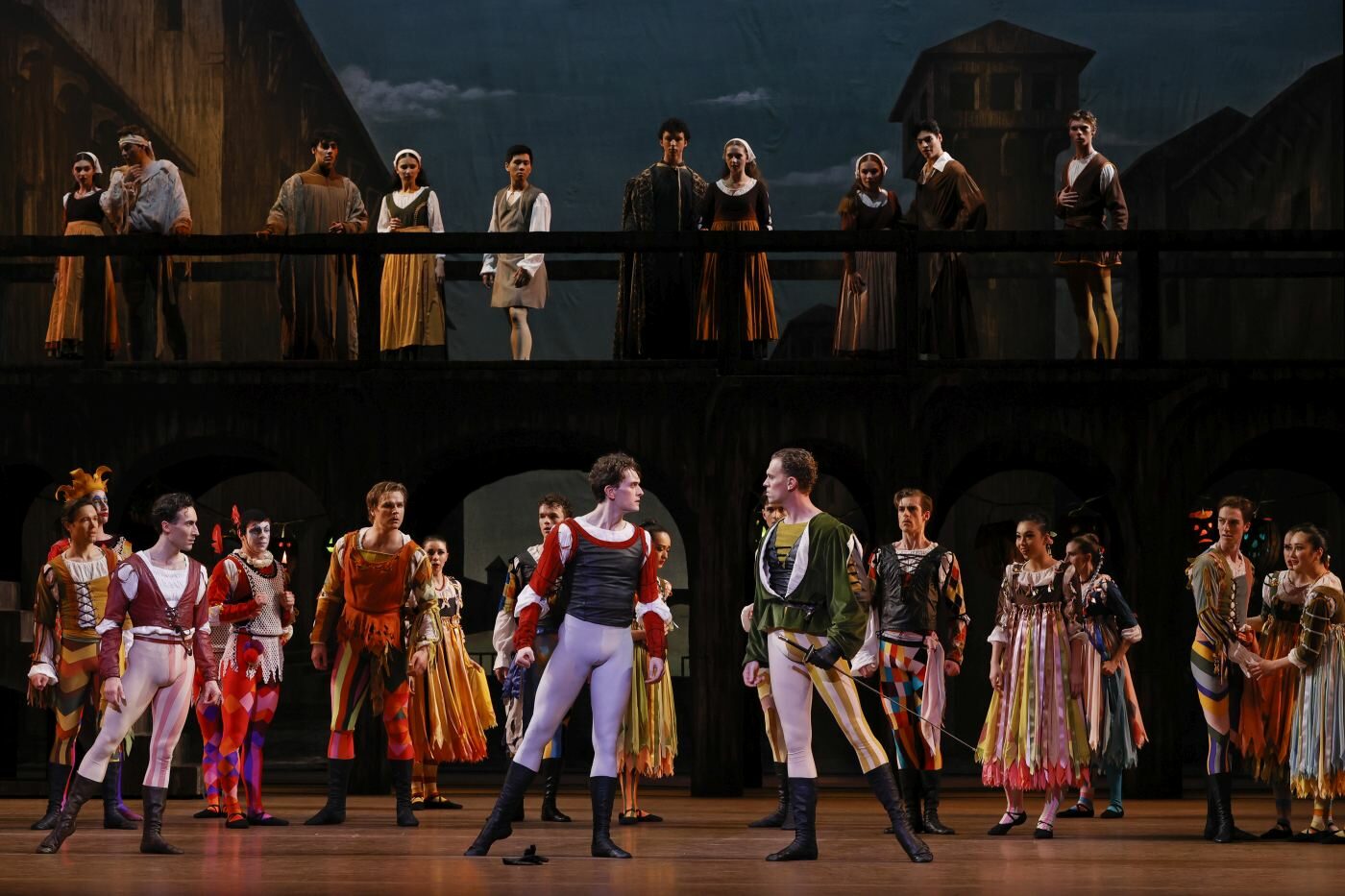“Hakanaï”
Adrien M & Claire B
Festspielhaus Baden-Baden
Baden-Baden, Germany
February 04, 2023
by Ilona Landgraf
Copyright © 2023 by Ilona Landgraf
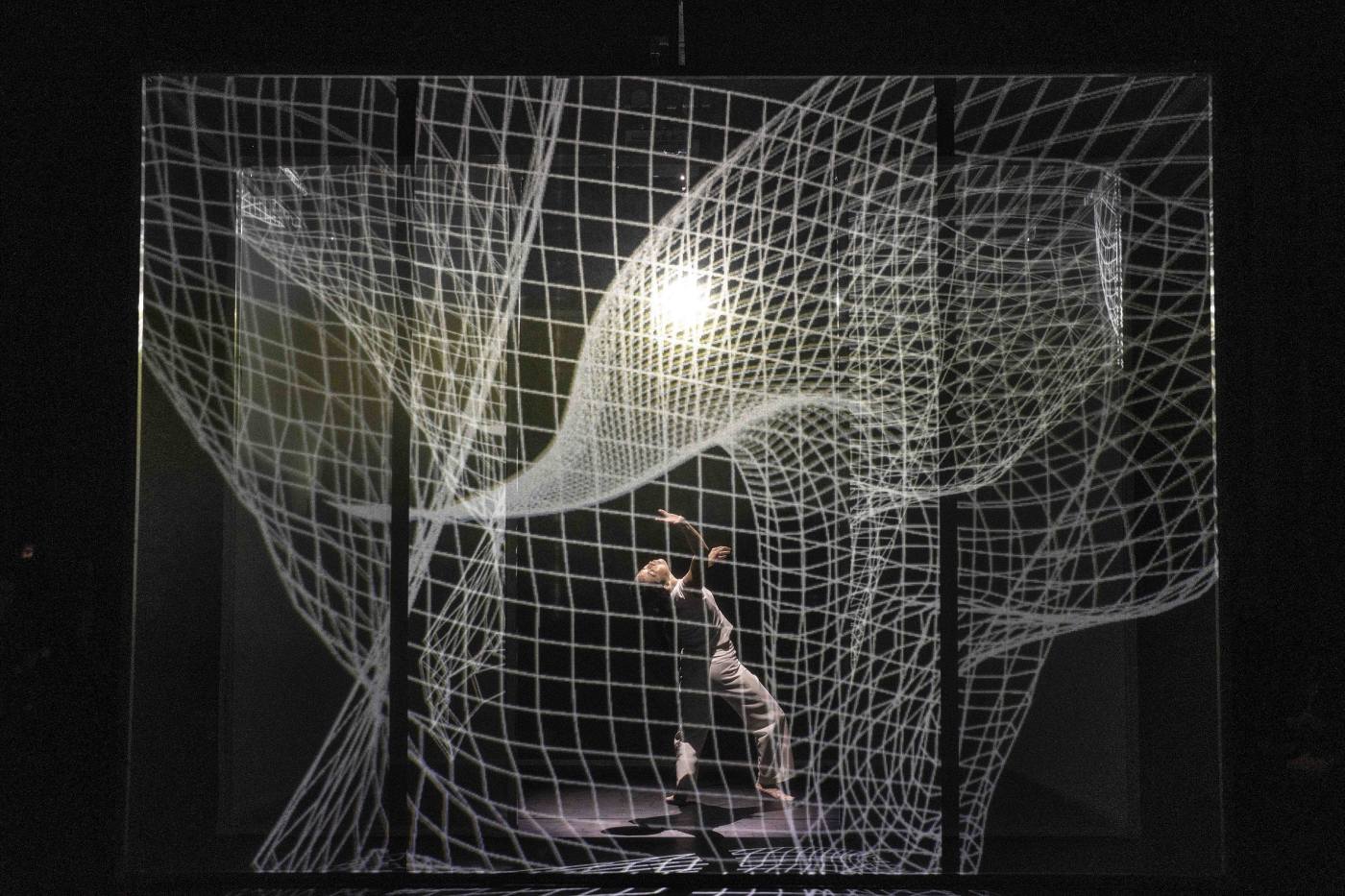 The survival of theaters and opera houses depends upon the survival of the audience. In an effort to lure the younger generation into their houses, the Festspielhaus Baden-Baden launched the Takeover Festival last year. Its three days of programming include concerts, dance, and workshops, as well as fun after-parties and a relaxed private lounge. Last weekend, the festival launched into its second round. I watched “Hakanaï” (Japanese for impermanent, fragile, evanescent, transitory, fleeting), a dance performance by the French-based troupe Adrien M & Claire B (short for Adrien Mondot and Claire Bardainne) that fuses movement with digital arts. The artistic team behind “Hakanaï” includes – among others – a computer designer, two sound designers, a light designer, two set designers, digital interpreters, sound interpreters – and one dancer: Akiko Kajihara.
The survival of theaters and opera houses depends upon the survival of the audience. In an effort to lure the younger generation into their houses, the Festspielhaus Baden-Baden launched the Takeover Festival last year. Its three days of programming include concerts, dance, and workshops, as well as fun after-parties and a relaxed private lounge. Last weekend, the festival launched into its second round. I watched “Hakanaï” (Japanese for impermanent, fragile, evanescent, transitory, fleeting), a dance performance by the French-based troupe Adrien M & Claire B (short for Adrien Mondot and Claire Bardainne) that fuses movement with digital arts. The artistic team behind “Hakanaï” includes – among others – a computer designer, two sound designers, a light designer, two set designers, digital interpreters, sound interpreters – and one dancer: Akiko Kajihara.
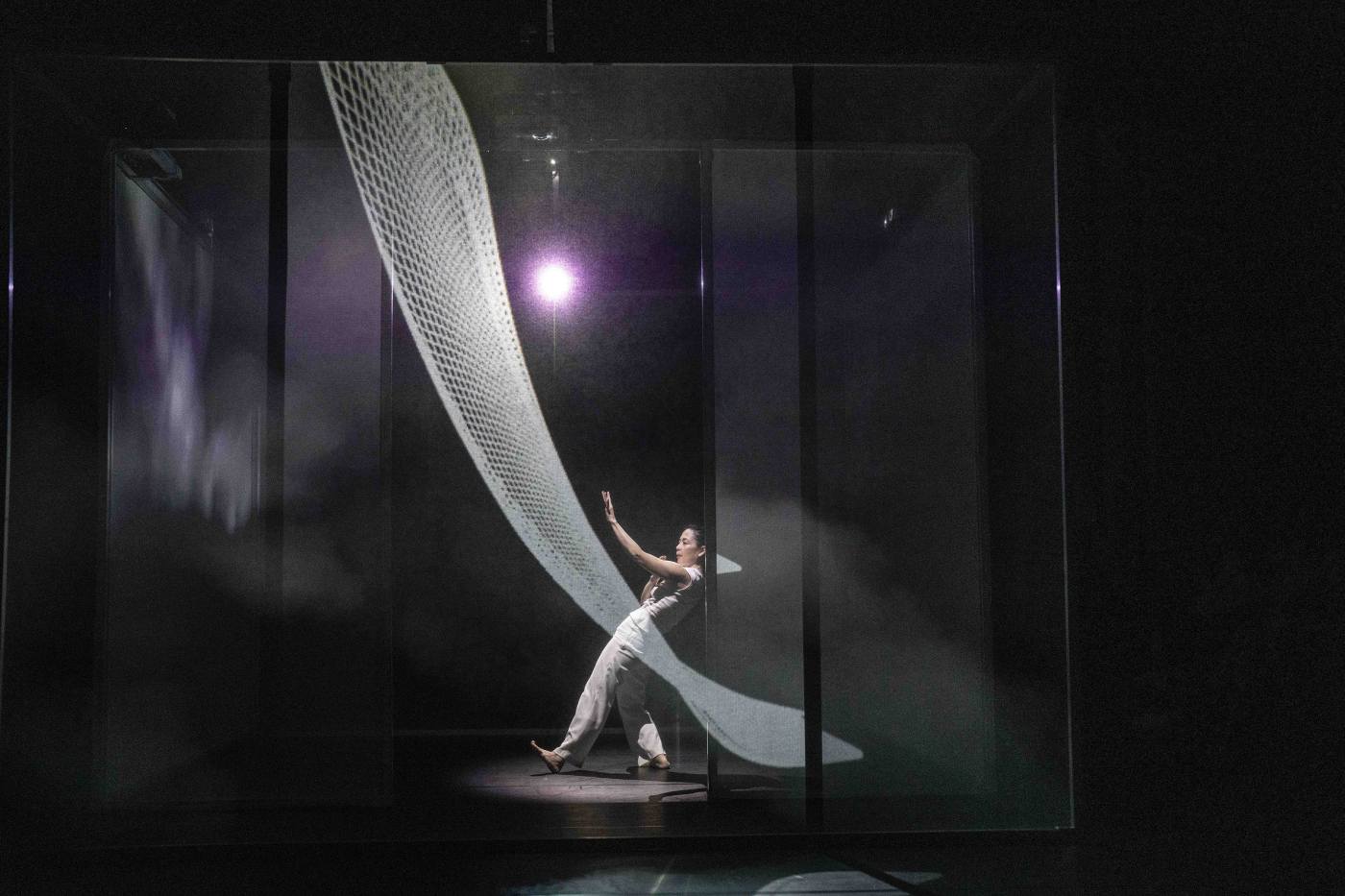 She performs “backstage” – where rows of chairs surround three sides of a cube that is as large as a cabin. A steady flow of white letters, symbols, and numbers crosses its semi-transparent surface, reflecting against the dark backstage walls. The quiet swoosh of surf accompanies Kajihara (wearing white pants and a white shirt) as she slowly walks around the cube. She enters it through an opening at the back, her legs stepping high over an imaginary threshold. Soothed by her gentle palm-taps and gestures, the letters and numbers slowly sink down and disappear. The empty space is soon filled by white light bars that expand upwards in sync with a hammering beat. With a final bang, the bars lock into a close-meshed grid. Kajihara appears to be locked behind bars, but it becomes clear that the grid, instead, is obeying her. Whenever she raises her hand, kicks her leg, or thrusts her hip or elbow, the grid responds to her movements. It can be pulled aside like a curtain; it flies; it swirls through the air like a tornado, hovering and billowing, following the instructions of its master. The grid that moments ago was folded into a small bundle is now one of the shreds of white fog that fill the cube.
She performs “backstage” – where rows of chairs surround three sides of a cube that is as large as a cabin. A steady flow of white letters, symbols, and numbers crosses its semi-transparent surface, reflecting against the dark backstage walls. The quiet swoosh of surf accompanies Kajihara (wearing white pants and a white shirt) as she slowly walks around the cube. She enters it through an opening at the back, her legs stepping high over an imaginary threshold. Soothed by her gentle palm-taps and gestures, the letters and numbers slowly sink down and disappear. The empty space is soon filled by white light bars that expand upwards in sync with a hammering beat. With a final bang, the bars lock into a close-meshed grid. Kajihara appears to be locked behind bars, but it becomes clear that the grid, instead, is obeying her. Whenever she raises her hand, kicks her leg, or thrusts her hip or elbow, the grid responds to her movements. It can be pulled aside like a curtain; it flies; it swirls through the air like a tornado, hovering and billowing, following the instructions of its master. The grid that moments ago was folded into a small bundle is now one of the shreds of white fog that fill the cube.
The fog becomes denser and is suddenly set ablaze with flickering bars of light that quickly flutter off and on (and strain the eyes).
It’s unclear whether Kajihara is trying to withstand the tormenting glare or the booming electronics. In any case, she staggers and falls, her hands covering her face. Watching the dissonant white pattern on the cube, I thought of the waves pulsing from an agitated brain.
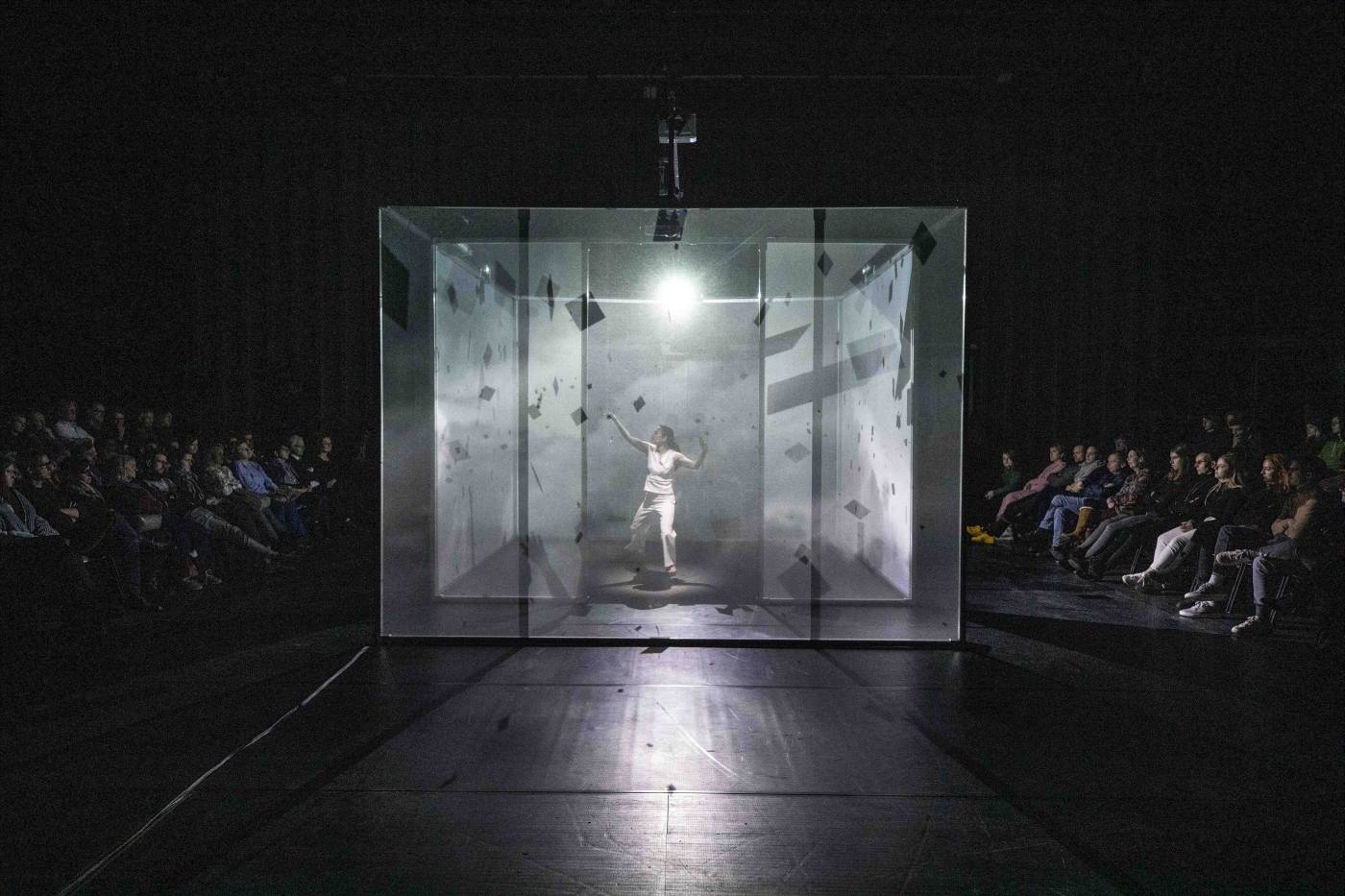 The big storm seems to have passed by the time soft hypnotizing sounds accompany Kajihara as she floats inside the cube like a baby in the bath. She rolls from her back to her belly, her legs gently paddling the air before she laboriously pulls hers to her feet. Moments later, the letters and numbers reappear, a terrible storm that assaults Kajihara from the side. She braces herself against the onslaught and nearly fails – but the storm drifts into the distance and the gentle plucking of a guitar indicates that peace has been restored. The cube is covered in a neuron-like web of light.
The big storm seems to have passed by the time soft hypnotizing sounds accompany Kajihara as she floats inside the cube like a baby in the bath. She rolls from her back to her belly, her legs gently paddling the air before she laboriously pulls hers to her feet. Moments later, the letters and numbers reappear, a terrible storm that assaults Kajihara from the side. She braces herself against the onslaught and nearly fails – but the storm drifts into the distance and the gentle plucking of a guitar indicates that peace has been restored. The cube is covered in a neuron-like web of light.
Yet again, the digital weather interferes. Thunderbolts plunge Kajihara into darkness. Her fingers crawl nervously through the air; her feet patter in a frenzy; her body trembles. Invisible obstacles seem to thwart her every attempt at movement. As if controlled by an unseen force, Kajihara cringes, shaken by staccato jerks.
When the dwindling sound of, perhaps, a tiny airplane engine is replaced by a few rain drops, Kajihara recovers. The rain quickly intensifies into a heavy downpour that solidifies into the same grid of light that surrounded her earlier. This time, though, explosions shatter the grid into pieces. The gray surface layer of the cube bursts apart, its fragments surrounding Kajihara before flying off. Kajihara leaves the cube, too – again stepping over the non-existent doorstep.
For me, “Hakanaï” provided a visual representation of the idea that every action impacts its surroundings and vice versa. It also made me think of the small digital boxes in which many have enclosed themselves – boxes that risk making you feel like you and it are the center of the universe.
Many audience members accepted the invitation to explore this box universe after the performance, setting the light grid into motion with their movements.
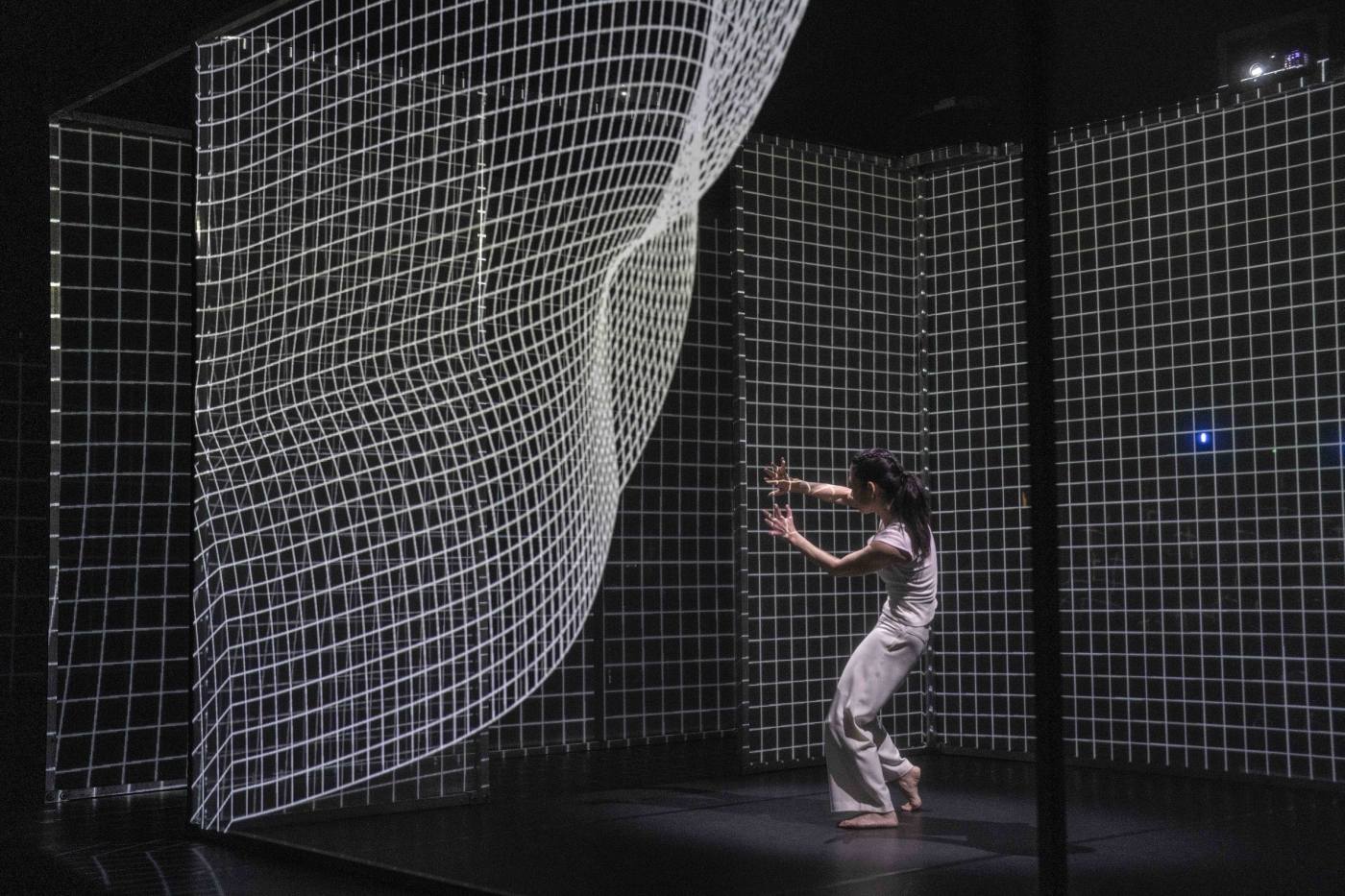
| Links: | Website of Adrien M & Claire B | |
| Website of the Festspielhaus Baden-Baden | ||
| “Hakanaï“ – Trailer | ||
| Photos: | 1. | Akiko Kajihara, “Hakanaï” by Claire Bardainne and Adrien Mondot, Adrien M & Claire B 2023 |
| 2. | Akiko Kajihara, “Hakanaï” by Claire Bardainne and Adrien Mondot, Adrien M & Claire B 2023 |
|
| 3. | Akiko Kajihara, “Hakanaï” by Claire Bardainne and Adrien Mondot, Adrien M & Claire B 2023 |
|
| 4. | Akiko Kajihara, “Hakanaï” by Claire Bardainne and Adrien Mondot, Adrien M & Claire B 2023 |
|
| all photos © Manolo Press / Michael Bode | ||
| Editing: | Jake Stepansky |
